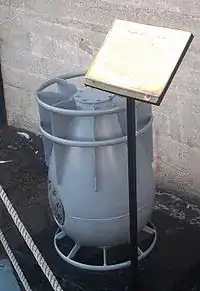قذيفة أعماق
قذيفة أعماق (بالإنجليزية: depth charge) هو سلاح الحرب المضادة للغواصات.[1][2][3] الغرض منه هو تدمير غواصة من خلال إسقاط قذيفة الأعماق في الماء في مكان قريب من الغواصة لتفجيره، حيث تخضع الغواصة أو الهدف لصدمة هيدروليكية قوية ومدمرة. معظم قذائف الأعماق، تستخدم شحنة متفجرات عالية التفجير ومجموعة صمامات لتفجير الشحنة على عمق معين. ويمكن إسقاط قذائف الأعماق من قبل السفن وطائرات الدوريات وطائرات الهليكوبتر.

قذيفة أعماق من نوع "مارك التاسعة" (Mark IX) والمستخدمة من قبل البحرية الامريكية في وقت متأخر من الحرب العالمية الثانية.
انظر أيضا
ملاحظات
- "معلومات عن قذيفة أعماق على موقع jstor.org". jstor.org. مؤرشف من الأصل في 14 أبريل 2020. الوسيط
|CitationClass=تم تجاهله (مساعدة) - "معلومات عن قذيفة أعماق على موقع catalog.archives.gov". catalog.archives.gov. مؤرشف من الأصل في 14 أبريل 2020. الوسيط
|CitationClass=تم تجاهله (مساعدة) - "معلومات عن قذيفة أعماق على موقع britannica.com". britannica.com. مؤرشف من الأصل في 24 يونيو 2019. الوسيط
|CitationClass=تم تجاهله (مساعدة)
المراجع
- Blair Jr., Clay (2001), Silent Victory: The US Submarine War against Japan, Annapolis, Maryland: Naval Institute Press الوسيط
|CitationClass=تم تجاهله (مساعدة); الوسيط|separator=تم تجاهله (مساعدة)CS1 maint: ref=harv (link) - Campbell, John (1985), Naval Weapons of World War Two, New York City: Naval Institute Press, ISBN 0-87021-459-4 الوسيط
|CitationClass=تم تجاهله (مساعدة); الوسيط|separator=تم تجاهله (مساعدة)CS1 maint: ref=harv (link) - Jones, Charles R. (January 1978), "Weapons Effects Primer", United States Naval Institute Proceedings الوسيط
|CitationClass=تم تجاهله (مساعدة); الوسيط|separator=تم تجاهله (مساعدة)CS1 maint: ref=harv (link) - Karhunen, Joppe (1980), Merilentäjät sodan taivaalla: meri-ilmailusta, suomalaisten merilentäjien vaiheista vv. 1918–39, talvi- ja jatkosodan taistelulennoista [Sea War II pilots in the sky: Marine Aviation, the Finnish sea pilots stages of vv. 1918-39, the Winter and Continuation War, the battle flights] (باللغة الفنلندية), Helsinki, Finland: Otava, ISBN 951-1-05830-4 الوسيط
|CitationClass=تم تجاهله (مساعدة); الوسيط|separator=تم تجاهله (مساعدة)CS1 maint: ref=harv (link) - Kershaw, Alex (2008), Escape from the Deep, Da Capo Press, ISBN 978-0-306-81519-5 الوسيط
|CitationClass=تم تجاهله (مساعدة); الوسيط|separator=تم تجاهله (مساعدة)CS1 maint: ref=harv (link) - McKee, Fraser M. (January 1993), "An Explosive Story: The Rise and Fall of the Depth Charge", The Northern Mariner, Ottawa, Ontario, Canada: Canadian Nautical Research Society in association with the North American Society for Oceanic History, III, صفحات 45–58, ISSN 1183-112X الوسيط
|CitationClass=تم تجاهله (مساعدة); الوسيط|separator=تم تجاهله (مساعدة)CS1 maint: ref=harv (link) - Tarrant, V. E. (1989), The U-Boat Offensive 1914-1945, New York: Sterling Publishing Company, ISBN 1-85409-520-X الوسيط
|CitationClass=تم تجاهله (مساعدة); الوسيط|separator=تم تجاهله (مساعدة)CS1 maint: ref=harv (link)
روابط خارجية
في كومنز صور وملفات عن: قذيفة أعماق
- in re Hermans, 48 F.2d 386, 388 (Court of Customs and Patent Appeals April 15, 1931) (“Meanwhile, however, the Naval Torpedo Station at Newport had developed a type of hydrostatically operated depth charge, which appeared at least the equal of even the latest British design. This firing mechanism was mainly the work of the Bureau's engineer of mines and explosives, Mr. C. T. Minkler. ... The American and British depth charges differ in several main particulars. Ours fires by means of hydrostatic pressure, while the British utilize the seepage principle also.”).
- http://www.maritime.org/doc/depthcharge6/part2.htm illustration and operation of the pistol
- بوابة ملاحة
- بوابة أسلحة
- بوابة الحرب
This article is issued from Wikipedia. The text is licensed under Creative Commons - Attribution - Sharealike. Additional terms may apply for the media files.
